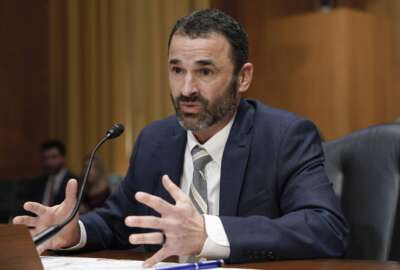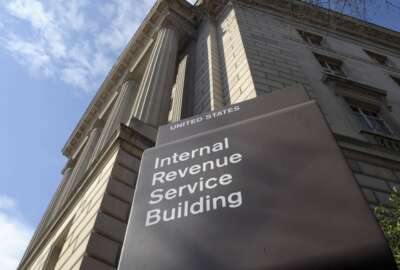Hubbard Radio Washington DC, LLC. All rights reserved. This website is not intended for users located within the European Economic Area.
IRS seeks 102,000-employee ‘right-sized’ workforce – and more money to maintain staffing
The IRS will use Inflation Reduction Act funds to increase customer service and enforcement personnel and grow its workforce through 2029.
The Internal Revenue Service plans to keep growing its workforce and make some long-deferred upgrades to its legacy IT systems, by tapping into billions of dollars in multi-year modernization funds.
The IRS, in an update to the Strategic Operating Plan it unveiled last year, will use what’s left of its $60 billion in multi-year Inflation Reduction Act (IRA) funds to increase customer service and enforcement personnel and grow its total employee headcount through 2029.
The agency is also looking to modernize some of the oldest legacy IT systems still running in the federal government, and use artificial intelligence tools to make data-informed audit decisions.
But the IRS is also warning Congress, which already cut $20 billion from the agency’s funds, that it won’t be able to complete all of its IT modernization projects or sustain its growing workforce without reversing those cuts.
IRS Commissioner Danny Werfel told reporters Thursday that the agency has already made a “sweeping array” of changes, and is delivering a much higher level of customer service to taxpayers by tapping into these funds.
“We’ve made fundamental changes that have improved taxpayer services, brought new fairness to compliance efforts, launched important upgrades to our technology, and made improvements that have made the IRS a more attractive place for people to work,” Werfel said.
The IRS is also planning to step up audit rates for high-income individuals and businesses.
It plans to nearly triple its audit rate to 22.6% for large corporations with assets over $250 million by tax year 2026 — up from 8.8% in 2019.
It also expects to increase audit rates by about 50% on individual taxpayers with more than $10 million in income — bringing audit rates up from 11% in 2019, to 16.5% in 2026.
“While the IRS has accomplished a lot so far with IRA funding, and under the Strategic Operating Plan, we have a lot more work to continue transformation efforts,” Werfel said.
The IRS, by tapping into Inflation Reduction Act funds, grew its workforce to about 90,000 full-time employees — up from its 79,000-employee headcount in 2022.
By 2029, the IRS plans on adding another 14,000 full-time employees. That would bring its workforce up to 102,500 total employees.
“We believe that figure represents a right-sized IRS, reflecting the need to serve taxpayers and responsibly enforce the law. Given the complexity of the nation’s tax laws, that number won’t even be a record high for the IRS workforce,” Werfel said.
The IRS’ workforce targets, he added, are still “well below” its peak staffing levels from the late 1980s and early 1990s.
The IRS hired about 2,000 revenue agents in 2024 — a 9% increase compared to last year. An additional 1,000 candidates are going through the onboarding process after receiving an IRS job offer.
“This report should later rest any lingering myth about a supersized IRS. As I believed all along, we were never going to add 87,000 additional employees — let alone 87,000 armed agents,” Werfel said.
Congressional Republicans, seeking to further cut the IRS’ multi-year modernization funds, have claimed the IRS would use this money to hire 87,000 agents.
The Treasury Department, in a May 2021 report, estimated the IRS could hire nearly 87,000 employees over a decade, if it received the then-proposed $80 billion in funding.
However, many of those hires will help the IRS keep up with its rate of attrition. The same report projects that 52,000 IRS employees will retire or otherwise leave the agency over six years.
“This report should bury, once and for all, any remaining misconception about the IRS bringing on 87,000 additional agents. We aren’t. The reality of it is much more down to earth,” Werfel said, adding that many of the new hires are replacing IRS employees or retiring or leaving to take other positions.
IRS is requesting $12.3 billion for its fiscal 2025 budget — a flat budget compared to current funding levels.
But the agency is also proposing Congress reverse a $20 billion cut to the IRS’ Inflation Reduction Act funds, and extend the multi-year funding through fiscal 2034.
All told, the IRS would receive $104 billion in multi-year funds under this budget proposal — up from the original $80 billion it received in the Inflation Reduction Act.
The IRS is telling Congress that its $104 billion funding proposal for the next 10 years would allow it to generate an additional $341 billion in tax revenue.
If Congress doesn’t approve this funding proposal, Werfel said the IRS would run out of funding for business systems modernization by 2026.
“If we hit a cliff, you’d see a situation in which we won’t be able to update our technology and keep pace. So, things might slow down or glitch more than they should, or you’ll see projects we were getting close to the finish line on, new functionality that was really going to be a benefit to taxpayers, and those not getting to where they need to be,” Werfel said.
If the IRS hits that funding cliff in 2026, he added that the IRS’ current 88% level of phone service could drop down to 30%.
“That would mean seven out of 10 taxpayers couldn’t reach us on the phone. That continues to be a concern for us,” Werfel said.” It’s critical that the IRS has stable secure funding to allow technology modernization and taxpayer service improvement to continue into the future.”
Werfel added that if the IRS doesn’t get additional funding, the agency won’t be able to sustain its growing workforce.
“When we hit a cliff, you see a combination of no longer being able to afford the employees. So how do you deal with that? It’s either you don’t replace people that retire, you furlough, and a last resort, you RIF,” he said, referring to a reduction in force. “Those are the realities that could happen.”
The IRS is also piloting a new approach to onboard new hires and improve the employee experience, and expects to expand the pilot later this year.
Werfel said this new approach to onboarding ensures new employees are “hitting the ground running, and that you’re finding that your choice to come to the IRS was a good one.”
“Because we’re hiring at a higher rate than we have previously, there’s more investment that are needed to on-ramp these employees on the basics. Like, when they arrive, are we all set with their badging? Are we all set with their computers, if they’re issued a computer or some type of technology? Are we prepared to orient through orientation — let’s say 50 employees showing up on a Monday, versus five, maybe, that was done previously?” he said.
Among its tech modernization projects, the IRS next year will also test out a long-awaited update to the Individual Master File, its authoritative data source for individual tax account data, and have the updated version up and running by next year’s filing season.
Werfel said artificial intelligence tools are a “critical part of how we modernize,” and that the IRS will be able to answer more phone calls with automated solutions, such as voice bots or chatbots on the agency’s website.
By giving taxpayers more self-help options, or answering basic questions through automation, Werfel said AI tools will clear out phone lines “for others that have more complicated questions where they really do need a live assister.”
“We are working diligently to scale the number of instances of AI technology that can help taxpayers get responses very quickly either through chat or through voice bots on our call centers,” Werfel said.
The IRS is also using AI analytics to make more informed decisions about which individuals and businesses to audit, and determine whether there is a balance owed.
“We’re sitting down with a large, complex filer or a multinational corporation, maybe operating in a dozen different tax jurisdictions, with dozens of subsidiaries and wholly owned subsidiaries — maybe operating with different currencies. And we have to determine whether they’re compliant or not. It becomes a bit of a chess match, a complicated one. But it will always be a human decision from the IRS. We just might have the computer help us and advise us on the chessboard.”
Copyright © 2024 Federal News Network. All rights reserved. This website is not intended for users located within the European Economic Area.
Jory Heckman
Jory Heckman is a reporter at Federal News Network covering U.S. Postal Service, IRS, big data and technology issues.
Follow @jheckmanWFED





